
CO2 Evolution Test (Sturm Test)
OECD 301 B, Regulation (EC) No 440/2008, C.4-C, DIN EN ISO 9439, ISO 14852 as well as ASTM D5864-11
Principle
The „CO2 Evolution Test“ is a method to determine the “ready” ultimate biodegradability of non-volatile chemicals in aqueous media.
Abstract
The amount of CO2 produced by the biodegradation of substances is determined. The test item as sole source of carbon is incubated together with activated sludge of a municipal sewage treatment plant (30 mg/L) and a mineral media for 28 days. The test vessels are aerated with CO2-free air. The resulting CO2 is absorbed in NaOH in successively connected absorption bottles as NaHCO3/Na2CO3. The amount of CO2 bound in NaOH is determined as DIC (dissolved inorganic carbon) and is a direct measure for the mineralised carbon of the test substance, after subtraction of the blank values.
Criteria
A degradation extent of > 60% ThOD within 28 days and within a "10-days window" after the end of the lag-phase is defined as criterion for classifying a particular test substance as "readily” biodegradable.
Test substance properties
The CO2 evolution test is applicable for soluble and insoluble substances as well as nitrogen-containing materials without disturbances caused by oxygen-consuming nitrification processes.
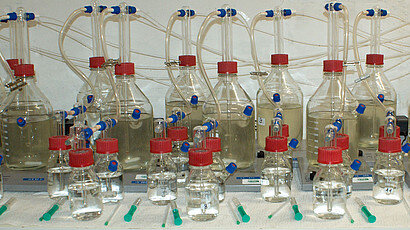
Manometric Respirometry Test
OECD 301 F, Regulation (EC) No 440/2008,C.4-E, DIN EN ISO 10707
Principle
Determination of biodegradability via oxygen consumption in closed respirometers.
Abstract
The manometric respirometry test determines the oxygen consumption in closed respirometers via semi-continuous pressure measurement. The test substance is the only carbon source in a mineralic medium. As standard, 30 mg/L of activated sludge from a municipal wastewater treatment plant are used. The under-pressure caused by the oxygen consumption is recorded over a period of 28 days. The released carbon dioxide is bound to NaOH. The biological degradation extent is calculated by the relation of the oxygen consumption (minus the oxygen consumption of the blank controls) and the theoretical or chemicals oxygen demand (ThOD or COD).
Criteria
A degradation extent of > 60% ThOD (or COD) within 28 days and within a "10-days window" after the end of the lag-phase is defined as criterion for classifying a particular test substance as "readily” biodegradable.
Test substance properties
The Manometric Respirometry Test is applicable for soluble and insoluble substances, substances with a high volatility and waste water samples.
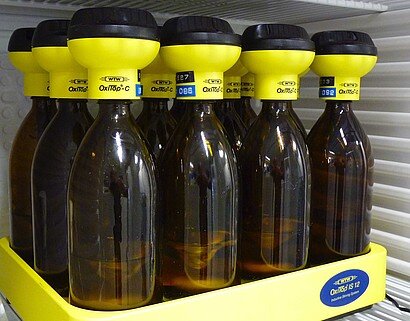
Enhanced ready Tests
OECD 301 B and F, Regulation (EC) Nr. 440/2008, C.4-C and C.4-D
Background
Enhanced screening tests serve as a link between the screening tests of the OECD 301 series and elaborate simulation studies with 14C-labeled substances, in accordance with the ECHA strategy for persistence assessment. Since the enhanced tests build on the tests for determining ready biodegradability, they are referred to as "Enhanced Ready Biodegradability Tests"(eRBT). According to ECHA guidance, the currently accepted enhancements ("enhancements") are an extension of the test duration up to 60 days and the use of larger test vessels. Enhanced screening tests are used to assess whether a test substance can be classified as "non-persistent" in the environment. Only test methods that detect mineralization by CO2 evolution (OECD 301 B or OECD 310) or by oxygen consumption (OECD 301 F) are used. In the assessment of microplastics according to "ANNEX XV Restriction Report on Intentionally Added Microplastics", eRBTs represent one of 4 test categories.
Description
The evaluation criteria have not yet been finalized. In a research project for the Federal Environment Agency, proposals were developed by Hydrotox GmbH. A degree of degradation of ≥ 60% of ThOD or ThCO2 within 60 days is considered evidence that the test item is not persistent. However, the reverse conclusion, according to which a degradation of < 60% THOD or rahter ThCO2 is an indication of persistence, is admissible. Proposals to derive “inherent degradability” from eRBT results have not yet been agreed either.
Further information
Gartiser S., Brunswik-Titze, A., Flach, F., Junker, T. Further development of screening tests for the evaluation of potential PBT substances. Final Report FKZ 3718 65 410 0, UBA-Texte series 10/2023, January 2023
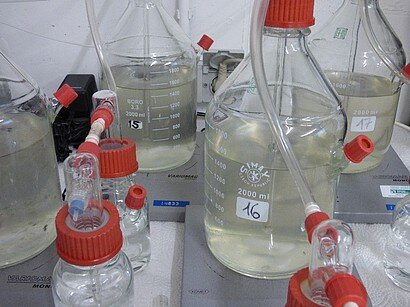
CO2-Headspace Test
OECD 310, Regulation (EC) No 440/2008, C.29, and DIN EN ISO 14593
The CO2 headspace test describes a procedure to determine the biodegradability of test items by measuring the CO2-evolution in sealed serum flasks with a headspace volume of about a third of the total flask volume. The test item, as sole source of carbon corresponding to 2 - 40 mg C/l, is added to a mineral salts medium, and is inoculated with activated sludge (4 mg d.s. /L). The oxygen needed for biodegradation is supplied from the headspace-volume. The test flasks are sealed and incubated at 20 - 25 °C in diffuse light for 28 days while being shaken. Degradation is followed by determining the carbon dioxide produced via TIC-measurement (TIC= total inorganic carbon) after absorption to sodium hydroxide.
For doing this, at least weekly about three flasks each from the test flasks, blanks and reference flasks were taken for TIC-measurements. As a control of the procedure the biodegradation of the reference items potassium phthalate or sodium benzoate is determined in parallel flasks.
The amount of carbon dioxide produced from the test item less the amount derived from the blank inoculum is expressed as a percentage of ThIC (theoretical amount of inorganic carbon), which corresponds to the TOC (total organic carbon). Additionally the DOC-elimination can optionally be determined for water soluble test items. According to ISO 14593 the mean value of biodegradation reached in the plateau phase or the highest level of biodegradation (if the curve decreases in the plateau phase) indicates the "degree of biodegradation of the test compound". Additionally the criterion for the ready biodegradability of OECD 310 is considered. Here the pass level for ready biodegradability is 60% of ThIC and this must be reached within a 10-days window (10 days after the degree of biodegradation has reached 10%). The test method is suitable for water soluble and non-soluble as well as foaming and volatile test items which are not toxic under the test conditions. The method has been chosen as a reference method for biodegradability testing in the (EC) Regulation 648/2004 on detergents.
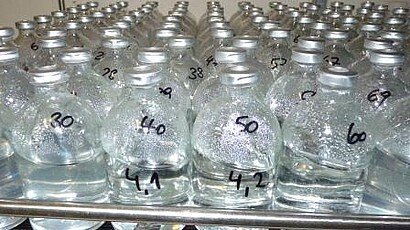
Closed bottle test
OECD 301 D, Regulation (EC) No 440/2008,C.4-E, DIN EN ISO 10707
The Closed Bottle Test is the classical test method for "ready” biodegradability. A medium with a mineral substratum and the test substance as the only carbon source is inoculated by a relatively low amount of microorganisms taken from a mixed culture. Subsequently, the biochemical oxygen demand is determined in regular intervals over a period of 28 days, by means of test bottles prepared in parallel and withdrawn again after determination. Biodegradation is then calculated from the ratio between the oxygen consumption that is caused by the degradation of the test item (corrected by the blank values of the inoculum), and the theoretical oxygen demand (ThOD), or alternatively the chemical oxygen demand (COD).
The test concentration is about 2 - 10 mg test substance per litre. Effluents from outflow of a municipal wastewater treatment plant are used as standard inoculum. A degradation extent of > 60% ThOD within 28 days and within a "10-days window" after the end of the lag-phase is defined as criterion for classifying a particular test substance as "readily” biodegradable.
The advantage of the "closed bottle test“ is its simple performance, the possibility to study also poorly soluble and volatile test compounds, as well as the low test concentrations required. This allows getting below possible effect threshold levels that are toxic to bacteria. Disadvantageous is on the one hand the low density of inoculation of a few ml of cleaned wastewater per litre, and on the other hand the oxygen reduction that is caused by the consumption of oxygen due to nitrification. For this reason, the test application is limited if slowly degradable and/or nitrogen-rich substances have to be studied.
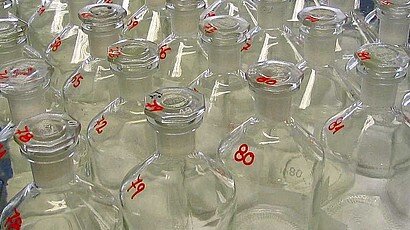
Modified OECD-Screening Test and DOC Die-Away Test
OECD 301 A und E, Regulation (EC) No 440/2008, C.4-A and C.4-B, DIN EN ISO 7827
Principle
Determination of the biodegradability via DOC-elimination.
Abstract
Degradability is measured by the decrease of the dissolved organic carbon (DOC) in a batch test with a low inoculum density. The test item is the only carbon source in a mineralic medium which is incubated with the effluent of a municipal sewage treatment plant for 28 days. Degradation is followed by DOC analysis. The degree of biodegradation is calculated by expressing the concentration of DOC removed (corrected for that in the blank inoculum control) as a percentage of the concentration initially present. Primary biodegradation may also be calculated from supplemental chemical analysis of parent compound samples that were taken at the beginning and at the end of incubation.
Criteria
A DOC degradation degree of at least 70% within 28 days and within a "10-days window" after the end of the lag-phase is defined as criterion for classifying a particular test substance as "readily” biodegradable.
Test substance properties
The „OECD Screening Test“ and the „DOC Die-Away Test“ are applicable to determine the “ready” biodegradability of water-soluble and non-volatile organic substances.

